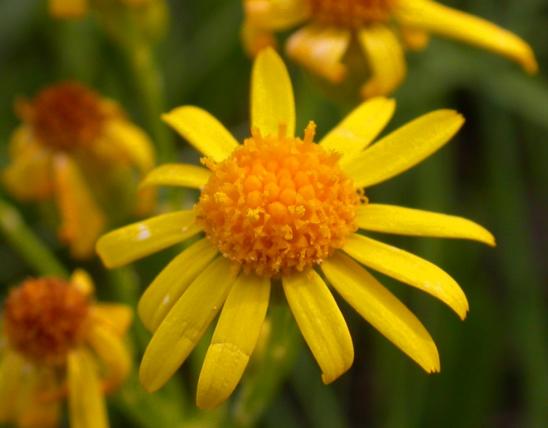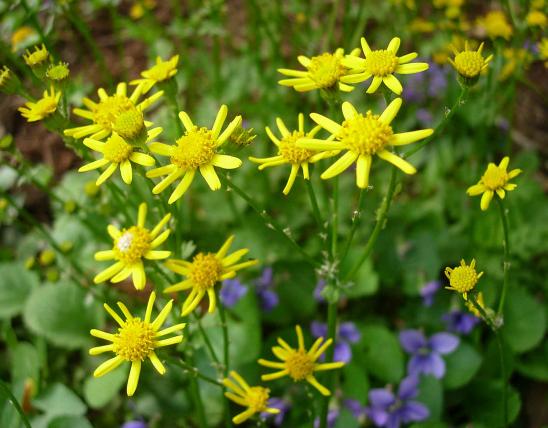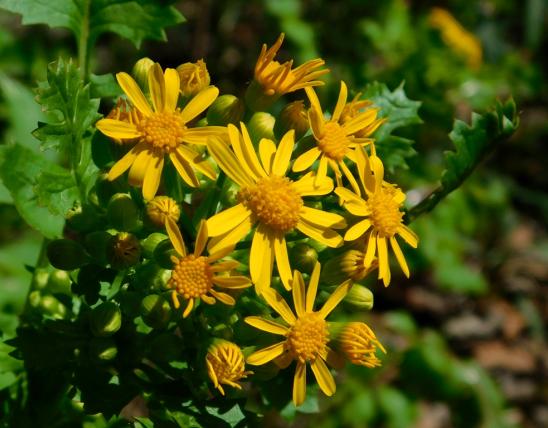
Prairie ragwort is a perennial wildflower that starts out as a hairy plant with white, cobwebby hairs; these are often worn away by flowering time except for patches at the leaf bases or flower cluster branch points. The leaves are mostly basal; the lowest of these have paddle-shaped blades with a pointed tip and have long petioles (leaf stems); the base of the blade tapers or is abruptly contracted where it joins the petiole. The lowest stem leaves are deeply pinnately lobed or appear pinnately compound. The stem leaves are few, sessile (clasping), and short. The basal and the stem leaves are sharply toothed. Flowerheads are few to many, terminal, with few ray flowers. Blooms May–June. The prairie/grassland habitat helps to identify this ragwort.
Learn more about Missouri’s ragworts on their group page.
Similar species: Seven Packera species occur in Missouri, plus a number of hybrids having intermediate characteristics that make identification tricky. The best characters for distinguishing among Missouri’s ragwort species are the leaves, especially the basal leaves, if they are present at flowering time.
The Missouri ragwort that’s most difficult to distinguish from prairie ragwort is northern ragwort, or balsam groundsel (P. paupercula). It is closely related to prairie ragwort and grows in the same kinds of habitats. It is scattered in Missouri, mostly in the northern half of the state. It blooms April–August. Northern ragwort tends to lose more of its hair as it matures, while prairie ragwort retains more. Northern ragwort tends more commonly to produce short rhizomes with few stolons (runners), while prairie ragwort more commonly produces slender stolons (runners). The leaf blades of northern ragwort are usually more than 3 times as long as they are wide, while those of prairie ragwort are less than 3 times as long as wide.
Height: to about 2 feet.
Scattered nearly statewide.
Habitat and Conservation
Occurs in upland prairies, loess hill prairies, glades, ledges and tops of bluffs, openings of mesic to dry upland forests, and rarely stream banks; also on pastures, railroads, roadsides, and open, disturbed areas.
Status
Native Missouri prairie wildflower.
Popular in native wildflower gardening and for naturalizing in prairie plantings.
Plants are toxic if eaten by people, livestock, or other animals.
Missouri’s species in genus Packera used to be grouped with about 3,000 other species into a gigantic genus Senecio. Today, even with the packeras and several other groups split away, Senecio is still a huge genus with more than 1,200 species, mostly in the Old World. Only two species of true senecios have been recorded in Missouri, both introduced/nonnative and uncommon.
Human Connections
Ragworts contain toxic pyrrolizidine alkaloid chemicals and are poisonous if eaten. They also have a long history as medicinal plants. Native Americans, settlers, and others have used them for treating a variety of ailments, including delayed and irregular menstruation and complications of childbirth. This is apparently how these plants acquired one of their common names, since they were associated with women’s reproductive health issues.
The genus name, Packera, honors Canadian botanist John G. Packer (1929–2019), who was born and raised in England but moved to Edmonton, where at the University of Alberta he became an authority on Arctic and alpine plants and literally wrote the book on the flora of Alberta.
The species name, plattensis, means “from the Platte” and refers to the Platte River, the locality whence this species was originally collected. The Platte River runs through Nebraska and joins the Missouri River south of Omaha.
Ecosystem Connections
Deer, rabbits, livestock, and other herbivorous mammals tend to avoid ragworts due to toxic pyrrolizidine alkaloid chemicals in the plants’ tissues.
A wide variety of bees, flies, beetles, and other insects visit the flowers for nectar and pollen.
The white-crossed seed bug (Neacoryphus bicrucis) and the caterpillars of a geometrid moth called “the gem” (Orthonama obstipata) are two kinds of insects that feed on ragworts. At least in the case of the seed bug, the plant’s toxic chemicals are stored in the insect’s body, providing it protection from predators.
Prairie spring wildflowers, such as prairie ragwort, need to accomplish their mission of blooming and producing seeds before the tall grasses all around them grow tall and crowd them out. Take time in April, May, and early June to visit a native tallgrass prairie to enjoy the beautiful variety of knee-high and shorter spring wildflowers.



































